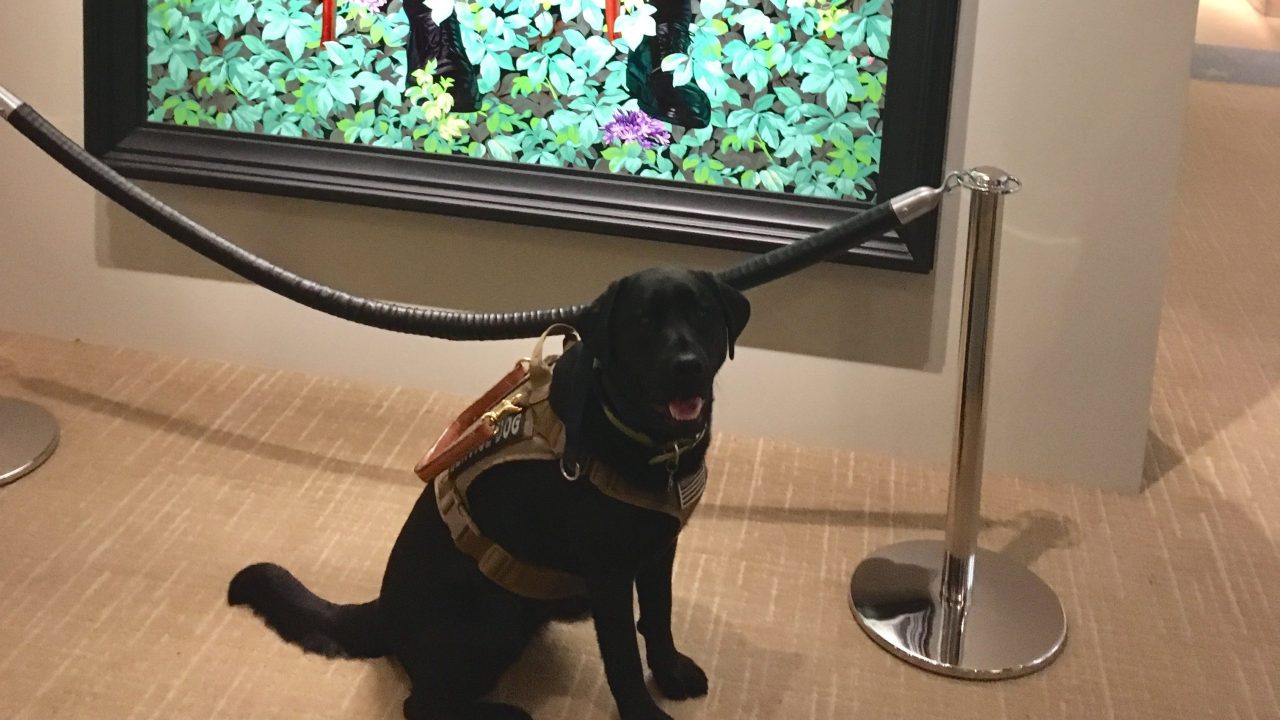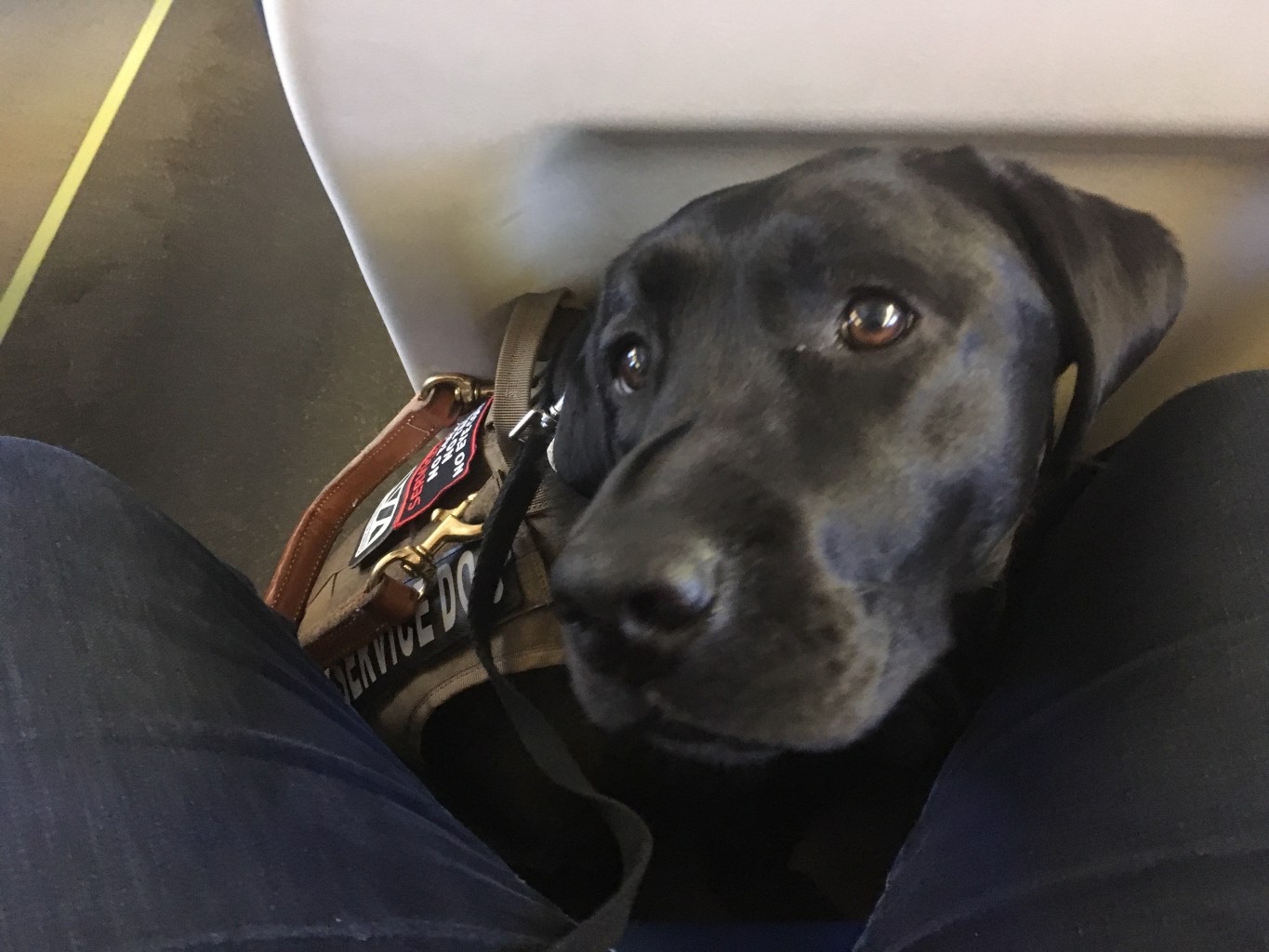
Service dogs are becoming more common as the years go on, and as museum professionals it can be a challenge to welcome them in among our collections. We worry about hair and dander, physical damage, and health code violations. Most of us see dogs as pets—lovable, but often unruly, and capable of wreaking more havoc than a toddler at a birthday party. Service dogs, however, have training and behavior which make them different from other dogs, meaning many of these concerns are unwarranted.
I have a special stake in the topic, because I am both a book and paper conservator and a veteran of the Iraq War with an invisible disability. To help mitigate some of my issues, I use my service dog, Coira. I’m here to help you navigate the rocky waters of service dogs in museums, archives, and collections facilities.
As museum workers committed to the highest standards of our profession, we all acknowledge that our goal is to make our spaces, programs, and resources accessible to our communities. This is not only a priority in our field, as captured in AAM’s 2016-2020 Strategic Plan, but also a requirement from the outside, because physical access to public spaces is enforced by law. To meet that requirement, we have wheelchair ramps, accessible bathrooms, and elevators; but allowing animals into our spaces can be confusing and complicated.

Terminology
To begin, you need to understand the difference between service dogs, therapy dogs, and emotional support animals. Service dogs are trained to mitigate the disability or disabilities of a single person, with guide dogs for blindness as an example. Therapy dogs are to provide emotional support for many people, such as a therapy dog in the children’s ward at a hospital. Emotional support animals are to provide emotional support through companionship. This easy graphic is really helpful.
Access
Handling access for service animals (who are almost always dogs) has the potential to be tricky. According to the Americans with Disabilities Act, a service dog must be allowed the same access as its handler, because the legal status of the dog is the same as any other medical device. When determining access to a public space, you are legally allowed to ask two questions:
Is the dog needed to help with a disability?
What tasks is it trained to perform?
The answer to the first question should be yes—service dogs are to assist medically disabled people. The second question, what tasks the dog is trained to perform, can be a little tricky. It is up to the service dog’s handler how much detail they give, because they are essentially telling you as much as they can without divulging some of their private medical history. Staff cannot ask what a person’s disability is—this is both intrusive and illegal. Staff also cannot ask for a demonstration of the tasks the dog is trained to perform.
Trained tasks can include:
- Mobility assistance (such as pulling, bracing, stabilizing, guiding)
- Retrieval (fetching dropped items, bringing items to the person, or going to get help)
- Indication (alerting a deaf handler to sounds, or a blind handler that someone is standing behind them)
- Medical alert (sensing an oncoming seizure, diabetes alerts, allergy alerts)
Service animals are to help mitigate a person’s disability, which may or may not be visible. The dog’s purpose is to provide trained tasks for one person. These can be multiple tasks per person; often mine retrieves dropped items, provides stability for dizzy spells, and helps with mobility assistance such as standing from a kneeling position. My dog also comforts and soothes me, but this is not considered a “trained task” so I never list it when I’m asked about what tasks she is trained to perform. I can train her to respond to a psychological emergency—to interrupt flashbacks, or to ground me if I’m dissociating—but I can’t train her to “love” me when I’m feeling down. Again, providing companionship and love is a task for emotional support animals.
When granting access to service dogs, another challenge is that there is no federal regulating authority on service animals in the United States. This means that there are no official ID cards, vests, or certification papers a service dog handler must have for “proof”—all of that can be bought online without any evidence of a person’s disability or the animal’s training. Dogs are not legally required to wear a vest or show outward proof. I know how frustrating that can be, but the laws err on the side of allowing people across the economic spectrum to have this kind of medical device with as little financial drain as possible.
Service Dog Behavior
Aside from asking these questions, you can identify a trained service dog by its behavior. It helps immensely for visitor services staff to be aware of behavioral signs, so they can spot if someone tries to slip in a pet. A service dog shouldn’t be running around (unless performing a task for its handler such as bringing you admissions money), it should absolutely be potty-trained, it should not be making noise, it should not be bothering or intentionally distracting anyone else, and it should not be begging for food or attention from anyone but its handler.
If you witness a disruptive dog doing these things, it is up to its handler to correct its behavior. If the dog continues, despite the efforts of its handler, then it’s not trained well enough for public access, and you can ask the handler to remove the dog from the premises due to its behavior. In that case, you’re not kicking the handler out, you’re kicking the dog out. This might cause a stir, but if the dog is misbehaving, you have recourse to protect your organization and guests.
I know my dog sometimes acts out in public—she is, after all, just a dog, and has off days like we do. If I were approached and asked to leave in that instance, I’d likely be frustrated with her, but completely understanding of the organization and its situation. Additionally, if I were somewhere and someone else had a disruptive dog, I’d be extremely grateful for their removal. A disruptive animal can distract a service dog from their work, and they could miss some vital indications of a medical emergency.
How to Interact with a Service Dog Team
As part of your staff training concerning this, you may want to add in how to act properly around a service dog and its handler, who together are referred to as a team. I run into many people who are eager to be inviting, which is pleasant, but their eagerness runs the way of them walking forward to pet her and speaking to her, etc. It can be annoying in my case, because they are undermining my authority over my dog, but for me it is not fatal. For some people, though, it could be. The worst possible scenario is that the dog will be distracted and miss signals that preclude a seizure or other medical emergency, and for that reason distracting a working dog can have heavy legal penalties depending on your state’s laws. It is best to only glimpse down at the dog occasionally, not try to make eye contact with it, and to address the handler only. You wouldn’t coo at an oxygen tank, would you?
Eye contact isn’t something that many people consider distracting, but it can be hugely so for service dogs. We train them to make and hold eye contact, which comes right before a command, so they are very attentive to it. Sometimes someone will make and maintain eye contact with my dog, and she will stare back, waiting for them to command her, which leaves me in a difficult situation trying to get her focus back.
It is also best if you don’t ask to pet the dog. Most service dogs are very people-friendly, but this eagerness to meet people can distract them from doing their job. When I’m working with mine, the temptation to make a new friend can be too much for her, and she will respond positively to an outstretched hand and smiling face, completely halting me from walking along and going about my business. All handlers are different, though, and some allow their dog to greet people, at least in certain situations.
In sum, know your rights, and don’t be afraid to ask your two questions: Is this dog needed to help with a disability, and what tasks is it trained to perform? Stay up to date on ADA laws and regulations, and don’t be afraid to step in and protect your patrons and collections if the dog is misbehaving. These tips will see you through most of your interactions with the public and the rising number of support animals in public spaces.








This article is extremely helpful and I love the simple graphic. I do not have issue with people with service dogs, they have been clear and their dogs have been under control.
My question is, how do we deal with the emotional support and therapy dogs that people try to bring in. We have been burned by trying to err on the side of accessibility for all, but have had people knowingly mislead our host staff, by acting as if their emotional support dog is a service dog, and the dog was not under control. They have out and out lied, and yet these are also the folks who are quick to intimidate our staff and volunteers who are trying to tactfully figure out the situation.
How are we supposed to interact in that case? This is where our frustration comes from.
As a service dog user, I expect that if my dog is not under control you WILL ask us to leave. If the dog is not under control, it is just that simple. Ask the human to please remove the dog from the facility. You can be polite, but you do not have to agonize over being tactful. At the point that a dog is out of control or soiling indoors, the bar is pretty level for ANY dog, service or no – it needs to go.
My therapy dog has a bandanna identifying him as therapy dog in training. He is very well behaved so I guess I can bring him with me on Friday for a visit.
Can I bring my Therapy dog to Hagley Museum
Thank you for this simple bit of knowledge.
As the Visitor Services Division Chief for a National Museum, I really appreciate this article and your perspective. Thank you for sharing.